FOOD FOR THOUGHT
(WHAT TROUT EAT)
BACK TO TABLE OF CONTENTS
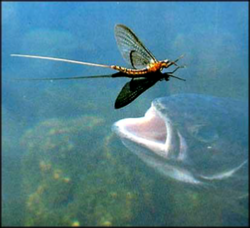 Trout are omnivorous, meaning if it moves they will probably eat it. There is no doubt that they have preferential food sources at certain times of the year and it is essential, therefore, to understand what these food sources are and where they are likely to be found. It will give us a good indication of where the fish are likely to congregate - and thus where to fish. Having said that, this information is intended to give a general outline to those interested in why trout do what they do and does not set out to be a technical dissertation on all things lepidopterous and insectivorous! By having an insight into the actions of the trout's food items it gives us a clue into where the trout may be at any particular time - and where you should be!
Trout are omnivorous, meaning if it moves they will probably eat it. There is no doubt that they have preferential food sources at certain times of the year and it is essential, therefore, to understand what these food sources are and where they are likely to be found. It will give us a good indication of where the fish are likely to congregate - and thus where to fish. Having said that, this information is intended to give a general outline to those interested in why trout do what they do and does not set out to be a technical dissertation on all things lepidopterous and insectivorous! By having an insight into the actions of the trout's food items it gives us a clue into where the trout may be at any particular time - and where you should be!
Don't expect the fish to be in these feeding zones at all times of the day - they aren't just eating machines. Just like you they will choose to eat when they are hungry, or when a food source becomes available - for example when a fly hatch leaves the shelter of the lake or stream bed. I have seen a poor chap slave away at a particular spot for hours and then I've slipped into his spot when he finally gave up, to be rewarded by a fine bag of trout within an hour. I knew the right time to be fishing that particular spot and he didn't. I did tell him to persevere but by then he'd had enough anyway. I've also watched my fish finder during the course of the day and actually seen fish echoes that have started off in the morning at the bottom of the lake and slowly risen during the course of the day. I suspect very strongly that they were following the fly nymph that was due to hatch that day as it made its way up through the water column. This leads me to believe that the time of day is critical to the depth at which you fish and the method you employ.
The same applies if you are in a boat. I once took over a mooring buoy when another angler decided enough was enough. A fine fish of over eleven pounds was in the net within ten minutes. You have to know what the fish are doing as well as where and when they are doing it. The other fisherman had been fishing with a floating line in the top few feet of water, whereas I used a booby and hi-d line to go down 30 feet and find the monsters lurking in the deeps. Why? Because it was nearly feeding time at the nearby cages and the big wild fish would move in to the area to vacuum up the pellets that fell through the netting. Once the cage feeding started it was useless to stay around because the fish would gorge on the pellets, but in the short period before feeding time they would readily accept a fly fished near the bottom.
COME FLY WITH ME
It is important to have a good knowledge of the life cycle of water related fly life, such as the mayfly and sedge. This will help you understand what is going on in the water and aid you in deciding what fly to offer. Remember that different flies have different life cycles and will be at different stages of their development at different times of the year. Mayfly are aptly named because the normal time for them to make their appearance is late spring and early summer, while the sedge - also known as caddis fly - tend to be a fly of high and late summer. Other flies may be more spread out in their hatching times and some will even have several generations hatching throughout the year. Acquiring this information will help you ensure that you have a similar fly imitation in your box when you get to the water.
A water related fly goes through several stages in its life and each stage has its own name to help in identification. Let's go through the life cycle of a mayfly - most water related flies will have most, if not all of these stages. A fly laying eggs at the surface of the water is called a spinner. This is the mature, mated form of the fly. It may shed the eggs loosely in the water or implant each individual egg into the stalk of the water vegetation. Those eggs will hatch within a few weeks into the larval stage of the life cycle. These larvae develop into nymphs and this stage of mayflies, dragonflies, stoneflies and damselflies are also called naiads. Smaller fly species will hatch into little wrigglers which will not develop into the crawling stage like a nymph but remain free swimming or hide in the bottom mud and these will carry the generic title of bloodworm. The nymphs - depending on the species - will normally live underwater for one or two years although in some species this can be as long as five years. I'll give you the odd technical word just so you can show off when the occasion arises; the word to describe the emergence of a larva from its egg or an insect from its pupal case is eclosion. And the pupal shell-like case it uses is called an indusium.
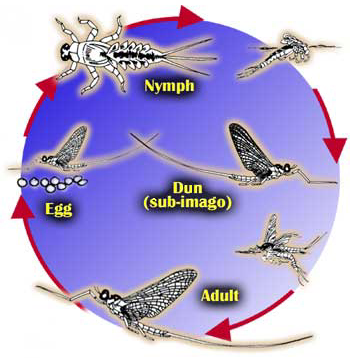
As the nymphs grow they are unable to expand their shell-like covering and will have to shed their outer skin - their exoskeleton - several times. This is like a crab shedding its shell to enable it to carry on growing. This exoskeleton is made of chitin, the general purpose material used by most insects as their outer protection. This material - which is a polysaccharide (a complex carbohydrate) - is so universally useful that Mother Nature also uses the same material for fungi to make their cell walls. Initially chitin is soft, pliable and elastic but once exposed to the elements it dries, hardens and becomes waterproof. This makes it ideal for forming body structures and once the existing outer shell is sloughed this new skin can swell before drying and hardening to become larger than the previous skin. This versatility enables the insect to go through several instars (the period between moults) during its waterborne life cycle. The shedding process has a technical word - ecdysis. From this the facetious word ecdysiast originates and it doesn't take a huge leap of the imagination to work out that this describes a striptease artist!
Some nymphs, such as the dragonfly, are highly aggressive and carnivorous, feeding on virtually anything that moves, including snails, tadpoles, small fish such as sticklebacks and even its own species. Other nymphal species, such as the caddis, may feed exclusively on vegetable matter or planktonic life such as algae. Eventually the nymph must answer the call of nature to reproduce and will swim to the surface. Here it will metamorphose into its next form to start the airborne part of its existence. As the nymph or pupa rises to the surface its emergence into the air can take a number of alternative courses. Some species attach themselves to the underside of the water meniscus by surface tension, where they are known as an emerger. Here it splits its chitin exoskeleton once again and pushes its way out and through the surface tension to come out of the water. At this stage it is known as a dun. It is still sexually immature which gives lie to its alternative name of sub-imago. Other species, especially the larger nymphs, will bypass this phase and simply crawl out of the water using a reed stalk or similar to climb up before resting and then going through their metamorphosis.
Having shed its skin the dun now stands on the water surface film or plant stalk while its newly acquired wings dry. This may only take a second or two. Then it will take to the air for its brief life on the wing. In the mayfly there is a final transformation when the dun undergoes another metamorphosis and skin moult, this time becoming the fully mature fly known as the imago. Imago is the scientific term for the fully mature version of the fly which is capable of reproducing. The angler also knows it as a spinner, which is where we started this sojourn.
Other species will bypass this final transformation and metamorphose just once when leaving the water. The most famous of this one stage species is the dragonfly, crawling out of the water onto the waterside vegetation, sloughing its skin and drying its wings to become the perfect predator in just one stage. Either way, this is the mating form of the fly. It will live for only a few weeks and in some species just a single night. The fly will rise up to form huge swarms which will mate on the wing.
Having mated, the males will die almost immediately, while the female will deposit her eggs into the water, which will start the cycle again. Some flies will even dive to implant each individual egg in underwater vegetation. This is where the idea of a wet fly imitation originates. This is the final act of life and the fly will then lie exhausted on the water, where it is called a spent. The dragon and damsel flies will live longer and the males will set up territories which they patrol looking for available females to mate with.
A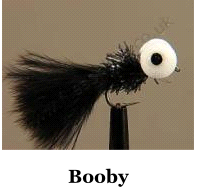 ll of these stages in the life cycle have their corresponding imitations in the fly fishing armoury. Our ubiquitous booby can be used to represent the nymphal stage, as can pheasant tail nymphs, although the two will be fished in completely different ways. The buoyant booby is a fly for the hi-d line, while the weighted ptn (pheasant tail nymph is often abbreviated just to confuse you!) is fished on a slow sink line.
ll of these stages in the life cycle have their corresponding imitations in the fly fishing armoury. Our ubiquitous booby can be used to represent the nymphal stage, as can pheasant tail nymphs, although the two will be fished in completely different ways. The buoyant booby is a fly for the hi-d line, while the weighted ptn (pheasant tail nymph is often abbreviated just to confuse you!) is fished on a slow sink line.
In the fly species where the submerged stage is spent as a larva, the buzzer is the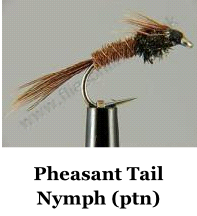 weapon of choice. This is fished on a long leader from a floating line or as a dropper to a buoyant fly or as part of a team of flies on a slow sink line. Whichever method you choose, the object of the exercise is to get the fly as near the bottom as possible without burying it in the bottom detritus. All these techniques are described in detail in other sections. It may now become clear why some fish take so forcefully when our artificial fly finishes its retrieve and sweeps up from the bottom of the water. This very strongly represents the real insect as it starts its journey to the surface. It may be the only few moments when the fish has the opportunity to take the real insect, which has previously been hiding in the bottom sediments.
weapon of choice. This is fished on a long leader from a floating line or as a dropper to a buoyant fly or as part of a team of flies on a slow sink line. Whichever method you choose, the object of the exercise is to get the fly as near the bottom as possible without burying it in the bottom detritus. All these techniques are described in detail in other sections. It may now become clear why some fish take so forcefully when our artificial fly finishes its retrieve and sweeps up from the bottom of the water. This very strongly represents the real insect as it starts its journey to the surface. It may be the only few moments when the fish has the opportunity to take the real insect, which has previously been hiding in the bottom sediments.
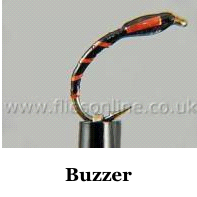 There are many emerger patterns that can sit in the surface film imitating the fly breaking through the surface tension. Some of these creations will have a cul de canard dressing - a particularly water resistant feather from the rear end of a duck (I don't make this up!) - to aid buoyancy. Many of these flies have the name "parachute" in their title to identify the way the fly looks with its upper appendage. Equally, there are a variety of dun and imago imitations available to match those particular moments in the fly's existence. This surface part of the fly's life is obviously fished as a floating fly on a floating line.
There are many emerger patterns that can sit in the surface film imitating the fly breaking through the surface tension. Some of these creations will have a cul de canard dressing - a particularly water resistant feather from the rear end of a duck (I don't make this up!) - to aid buoyancy. Many of these flies have the name "parachute" in their title to identify the way the fly looks with its upper appendage. Equally, there are a variety of dun and imago imitations available to match those particular moments in the fly's existence. This surface part of the fly's life is obviously fished as a floating fly on a floating line.
 The study of fly life associated with the river and still water is a science in itself, but it is worth knowing what species are likely to occur on the water that you intend to fish. Some are almost ubiquitous, such as the mayflies, while others can be very area specific. Equally, you can expect different flies to inhabit large still waters compared to small streams. Most of this education will come with time and observation of your chosen water but to get started you should concentrate on the widespread and generic beasties, such as nymph and pupae imitations.
The study of fly life associated with the river and still water is a science in itself, but it is worth knowing what species are likely to occur on the water that you intend to fish. Some are almost ubiquitous, such as the mayflies, while others can be very area specific. Equally, you can expect different flies to inhabit large still waters compared to small streams. Most of this education will come with time and observation of your chosen water but to get started you should concentrate on the widespread and generic beasties, such as nymph and pupae imitations.
WHAT'S IN A NAME?
In the section Meet the Family (of trout and salmon) we look at the way Latin names and groups are created to describe the various species. This is of importance again when looking at the different insects on which the fish feed. Getting to know these groupings will give you an insight into how different insects develop and thus what fly to offer to imitate the hidden underwater parts of their lives. Some of the names used here are of an individual species, some are of the family that they belong to and some are of the order that those families are included with. Many of these names are used by those in the know - probably just to confuse you - so here are the basic ones. They will be examined in more detail below.
Ephemeroptera include the mayflies; the Latin name means "short lived", which well describes the brief lives these flies enjoy - some have an airborne life of just a single night. Trichoptera are the caddis flies, also known as sedge; their Latin name means "hairy wing", which gives lie to the opaque moth like appearance of their wings. Plecoptera are the stoneflies; their Latin name means "twisted wing" which is an indication of their poor flying abilities. Diptera are a large order of flies and their name means "two wing", indicating the double wing formation they possess. Chironomidae are the genus of midges; their name origin is uncertain as the Latin root of Chiro means "hand". Then there are the Tipula, which are the genus which includes daddy-long-legs and crane flies; their name translates from the Latin for water spider. Finally there are the Odonata which are the dragonflies and damselflies. Their carnivorous lifestyle is suggested in their Latin name, which means "tooth".
MAYFLY
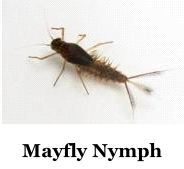 Of the order Ephemeroptera, these are upwing flies - they fold their wings vertically as opposed to horizontally like a dragonfly. Damsel flies also fold their wings into the upright position, so a fly showing this characteristic is not necessarily a mayfly. However, the mayflies are the only species to possess two or three long, stiff whip like tails which helps in identification. The mayfly life cycle has been described in detail above. While the major contributor to this category are the mayflies themselves, also included are the olives, which includes the medium, blue-winged, iron blue and spurwings. Other members of the category, like the Caenis are too small to imitate except on the tiniest of hooks.
Of the order Ephemeroptera, these are upwing flies - they fold their wings vertically as opposed to horizontally like a dragonfly. Damsel flies also fold their wings into the upright position, so a fly showing this characteristic is not necessarily a mayfly. However, the mayflies are the only species to possess two or three long, stiff whip like tails which helps in identification. The mayfly life cycle has been described in detail above. While the major contributor to this category are the mayflies themselves, also included are the olives, which includes the medium, blue-winged, iron blue and spurwings. Other members of the category, like the Caenis are too small to imitate except on the tiniest of hooks.
Mayfly are near universal but are most identified with chalk streams and freestone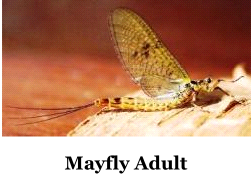 rivers. They are also found in larger lakes and, despite their name, will hatch throughout the year. In fact there are some small varieties of olive that are known to hatch in the middle of winter. As nymphs their various species may swim freely, creep through the water weed, hide under stones or occupy virtually any other evolutionary niche available to it.
rivers. They are also found in larger lakes and, despite their name, will hatch throughout the year. In fact there are some small varieties of olive that are known to hatch in the middle of winter. As nymphs their various species may swim freely, creep through the water weed, hide under stones or occupy virtually any other evolutionary niche available to it.
An indication of the variety of these flies comes from some of their names: Blue winged olive, small dark olive, medium olive, large dark olive, the danica and vulgata species of the mayfly itself, the claret dun, the sepia dun, the yellow May and the March brown to name just a few.
Mayflies can be further sub-divided depending on the type of lifestyle that have adopted. There are four categories and it is good to know which species inhabits your chosen water as it will give you a head start when deciding on what is the best method of fishing.
Clingers These inhabit fast flowing water and have flattened bodies to ensure the current flows over them and push them against the rocks. They also have strong legs to enable them to push against the flow of the current. Because they are always flattened in this way they have evolved their eyes onto the tops of their heads. They mainly belong to the family Heptageniidae.
Crawlers These inhabit slower flowing water, so the need to be super streamlined is not so important. It also means they can afford to grow to a larger size as they are less likely to be swept away by the current. Their eyes will be found on the sides of their heads. These are one of the most numerous types and comprise five families - Ephemerellidae, Leptophlebiidae, Leptohyphidae, Caenidae and Baetiscidae.
Swimmers These free swimmers have long slender bodies and long fragile legs. Their tails are hairy and are used as paddles. They have mainly two families - Baetidae and Siphlonoridae.
Burrowers These are the largest of all in size, burrowing in the soft mud and sediment of the still backwaters. They can grow up to 1½ inches in size, with mandibular tusks and spade shaped heads to aid in their digging activities. There are three important families - Ephemeridae, Potamanthidae and Polymitarcidae.
There are many different species of just this one fly, so it is not surprising that a dedicated angler could spend an entire lifetime exploring his chosen water and still not see all the treasures it has to offer.
CADDIS FLY
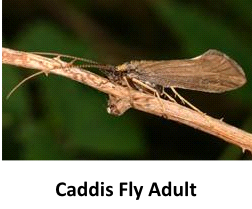 Of the order Trichoptera, the sedges are also included in this family. As mentioned above, the name means hairy wing and gives an indication of the moth like appearance of the wings on these creatures. Do not be confused, however, as the caddis fly wings are covered by tiny hairs, whereas the moth's wings are covered with tiny scales.
Of the order Trichoptera, the sedges are also included in this family. As mentioned above, the name means hairy wing and gives an indication of the moth like appearance of the wings on these creatures. Do not be confused, however, as the caddis fly wings are covered by tiny hairs, whereas the moth's wings are covered with tiny scales.
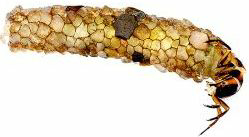 Many caddis fly larvae are soft bodied and protect themselves during their larval stage by building a case from available material, such as small stones or twigs, glued together with a silk from its mouth. This case may then be secured to the bottom of the lake or stream, where the larva lives in protected isolation. Other variants drag their home around, just like a hermit crab. The larva sieves plankton from the water with just its head protruding from its shelter. Different caddis flies will erect different cases, some types being very specific in their choice of material and the shape they build. Just to confuse you, there are some caddis variants that do not build shelters at all, but have developed a pair of hairy legs which it uses as paddles. This enables it to swim strongly, thus avoiding its predators.
Many caddis fly larvae are soft bodied and protect themselves during their larval stage by building a case from available material, such as small stones or twigs, glued together with a silk from its mouth. This case may then be secured to the bottom of the lake or stream, where the larva lives in protected isolation. Other variants drag their home around, just like a hermit crab. The larva sieves plankton from the water with just its head protruding from its shelter. Different caddis flies will erect different cases, some types being very specific in their choice of material and the shape they build. Just to confuse you, there are some caddis variants that do not build shelters at all, but have developed a pair of hairy legs which it uses as paddles. This enables it to swim strongly, thus avoiding its predators.
The time comes, however, when the caddis larva grows too big for its abode and it must then set about building a larger residence. During this time the larva is exposed and at risk. A trout will hunt for these homeless caddis larva and an artificial fly can imitate this stage in the life cycle. Moved slowly and close to the bottom a caddis fly larva imitation in green or orange can have good results.
An ideal fly for this nymph when sedge are hatching is the gold ribbed hare’s ear. They leave their self made homes and swim up through the water to emerge as the moth like fly with two long antennae. When making this upward journey they look very much like the hare’s ear nymph and this should be used on a floating line in the shallow areas of the water. A slow steady retrieve can bring violent takes!
 Caddis flies are unlike mayfly in that they pupate like a butterfly, albeit underwater. They seal the entrance to their case and metamorphose inside their chrysalis, changing from the larval to the adult form. Once this transformation is complete they break free of their case and make their way to the surface. However, they still have a waterproof covering called a shuck to protect themselves during this final journey up to the surface. This shuck is sloughed once the fly emerges from the water as the adult form.
Caddis flies are unlike mayfly in that they pupate like a butterfly, albeit underwater. They seal the entrance to their case and metamorphose inside their chrysalis, changing from the larval to the adult form. Once this transformation is complete they break free of their case and make their way to the surface. However, they still have a waterproof covering called a shuck to protect themselves during this final journey up to the surface. This shuck is sloughed once the fly emerges from the water as the adult form.
The rise of the caddis can be very impressive with flies numbering in their many thousands. The strange thing is that, though this can generate a rise in the trout, I have rarely found with the adult form in the trout's stomach when I have spooned a fish. Several reasons can been formulated for this, including the idea that the fly is too fast for the trout to catch. I have sometimes wondered if the adult fly becomes unpalatable during that final pupation as a protective measure to help ensure many of them make the final journey to the surface. It may just be that the heightened activity of the rising flies that gets the trout moving. Whatever the reason, trout will still take a fly during this time, but often fished as an emerger pattern rather than the imago form.
DRAGONS AND DAMSELS
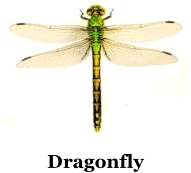 Of the order Odonata, the dragonfly is in the suborder Anisoptera while the damselfly is in the suborder Zygoptera. The most obvious distinguishing feature of these two creatures is that the dragonfly holds its wings out horizontally to its body, while the damselfly folds its wings along the length of its body. You may also notice that the dragonfly's eyes meet in the middle of its head, whereas the damsel fly's eyes are quite separate on either side of its head. Check out this video of a dragonfly nymph feeding to understand just how voracious they can be.
Of the order Odonata, the dragonfly is in the suborder Anisoptera while the damselfly is in the suborder Zygoptera. The most obvious distinguishing feature of these two creatures is that the dragonfly holds its wings out horizontally to its body, while the damselfly folds its wings along the length of its body. You may also notice that the dragonfly's eyes meet in the middle of its head, whereas the damsel fly's eyes are quite separate on either side of its head. Check out this video of a dragonfly nymph feeding to understand just how voracious they can be.
And this video showing how the nymph is jet propelled. This is a good indication of how a booby should be worked through the water.
Both dragonflies and damselflies are highly aggressive and territorial as well as being carnivorous. They will easily take other fly species in mid-flight. They are famed for being able to fly backwards as well as forwards. Most river banks are not complete without their dragons fighting for aerial supremacy and the right to mate with any visiting females.
Their larvae, which live submerged for up to five years, are also highly predatory and carnivorous. The dragonfly nymph has a rear opening in its body through which it sucks in water for respiration. This water inlet is also used for other purposes. When the creature needs an extra turn of speed it expels the water at high velocity, effectively turning the vent into a jet engine. This jet engine is used both as a means of escape and also when hunting, giving it an extra turn of speed.
 It also uses this vent in another interesting way. When it is ready to seize its prey, it closes the vent and uses the same system that it uses for its propulsion. However, with the vent closed, this builds up pressure within the animal, which it uses to push forward its hinged mouth at great speed to grab its dinner. A damselfly larva does not have this jet propulsion system, instead having three feathery like appendages at its rear end through which it breathes.
It also uses this vent in another interesting way. When it is ready to seize its prey, it closes the vent and uses the same system that it uses for its propulsion. However, with the vent closed, this builds up pressure within the animal, which it uses to push forward its hinged mouth at great speed to grab its dinner. A damselfly larva does not have this jet propulsion system, instead having three feathery like appendages at its rear end through which it breathes.
 After several years of creating carnage underwater they crawl out of the water and up a plant stalk to go through their metamorphosis, splitting their skin and emerging as the adult form in about an hour. They pump fluid into their wings to stretch them as they dry. While drying the dragonfly's wings will flip out to the horizontal position where they will remain permanently. The damselfly's wings, on the other hand will remain in the folded back position at rest.
After several years of creating carnage underwater they crawl out of the water and up a plant stalk to go through their metamorphosis, splitting their skin and emerging as the adult form in about an hour. They pump fluid into their wings to stretch them as they dry. While drying the dragonfly's wings will flip out to the horizontal position where they will remain permanently. The damselfly's wings, on the other hand will remain in the folded back position at rest.
The damsel fly is much slimmer and has a more delicate body. Its name is derived from the French word demoiselle, meaning young lady which indicates its more refined appearance. Despite this, they are still carnivorous like their bulkier dragonfly relatives. During mating the male and female of both species clasp their partner in a classic heart shape and mate during flight. To ensure that it is his sperm that fertilizes her eggs, the male will continue to hold onto the female, even dipping her completely underwater while laying her eggs.
 Dragonflies will live for about two weeks in the adult form, the dominant male staking out a territory along the water's edge which it will defend ferociously. It will mate with any available females coming into its territory which will then inject her eggs into underwater plant stalks one at a time. If she is alone she will hover just above the surface and dip the end of her abdomen into the water. A sharp ovipositor makes an incision in the plant stalk into which a single egg is deposited.
Dragonflies will live for about two weeks in the adult form, the dominant male staking out a territory along the water's edge which it will defend ferociously. It will mate with any available females coming into its territory which will then inject her eggs into underwater plant stalks one at a time. If she is alone she will hover just above the surface and dip the end of her abdomen into the water. A sharp ovipositor makes an incision in the plant stalk into which a single egg is deposited.
 Imitating these creatures with an artificial fly falls into two main categories. First there is the nymphal stage to which our friend the booby readily lends itself. A crucial trick to remember is that action the dragonfly nymph uses to get a good turn of speed - using its rear vent to jet water. Using that piece of knowledge we can pull the booby back with short sharp tugs of an inch or two at a time. If you were a dragonfly nymph being stalked by a trout you surely would use your jet propelled means of escape and this is what most likely causes a strong strike response in the trout. It is a heart stopping moment when the rod tip suddenly buries itself in the water as the trout takes your escaping booby. Remember - be a jerk when imitating a dragonfly nymph with your booby!
Imitating these creatures with an artificial fly falls into two main categories. First there is the nymphal stage to which our friend the booby readily lends itself. A crucial trick to remember is that action the dragonfly nymph uses to get a good turn of speed - using its rear vent to jet water. Using that piece of knowledge we can pull the booby back with short sharp tugs of an inch or two at a time. If you were a dragonfly nymph being stalked by a trout you surely would use your jet propelled means of escape and this is what most likely causes a strong strike response in the trout. It is a heart stopping moment when the rod tip suddenly buries itself in the water as the trout takes your escaping booby. Remember - be a jerk when imitating a dragonfly nymph with your booby!
The second way we can imitate the dragonfly and damselfly is in its adult form. Without doubt, the mature and active fly is too agile to be of more than passing interest to a trout. But the life cycle of the creature is as short as two weeks in its aerial form, so the time comes when the spent creature falls to the surface in its dying throws. A dry fly of the right form and colour, fished on a floating line, twitched across the surface can bring a ferocious response.
There are about 40 species of dragonfly in the UK and these fall into a variety of genus. There are Aeshna, Anax, Coenagrion and Ischnura to name a few but it is unnecessary to remember all this detail. Your home territory will sport its own varieties, of which you should acquire a passing knowledge in order to match your flies appropriately.
STONEFLY
Of the order Plecoptera they are mainly found on flowing water with a gravel bottom. They require a highly oxygenated habitat, so they will not be found in turbid or still waters. Equally, waters that tend to become overly warm in summer will not create a conducive environment for the stonefly. Cold fast flowing streams with areas of rapids to provide that extra oxygenation are ideal habitats for the stonefly.
They live for between two and four years in their underwater nymphal form, so there is always a generation that is approaching maturity and consequently of a goodly size. For this reason, where they are present, they will represent an important food source. A mature adult can measure from as little as ¼ inch (6 mm) up to two inches (5 cm) long.
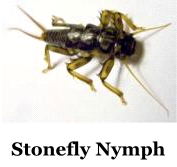 Living among the rocks and gravel, it is a bottom dwelling creature and the trout will forage for it. When mating time arrives - from early spring to late summer depending on the variety - some versions will adopt the mayfly method of surfacing and shucking on the water. Others adopt the dragonfly system of crawling up vegetation to split their exoskeleton and emerge as the adult form. Unlike the mayfly they undergo just this one metamorphosis, emerging as the adult form. They will live for several weeks, the female returning to the water several times to lay her eggs. At that time she is vulnerable to trout attack and an imitation on the surface can produce results. Similarly, when they end their lives they will be seen floating on the stream, again at the mercy of the ever hungry trout.
Living among the rocks and gravel, it is a bottom dwelling creature and the trout will forage for it. When mating time arrives - from early spring to late summer depending on the variety - some versions will adopt the mayfly method of surfacing and shucking on the water. Others adopt the dragonfly system of crawling up vegetation to split their exoskeleton and emerge as the adult form. Unlike the mayfly they undergo just this one metamorphosis, emerging as the adult form. They will live for several weeks, the female returning to the water several times to lay her eggs. At that time she is vulnerable to trout attack and an imitation on the surface can produce results. Similarly, when they end their lives they will be seen floating on the stream, again at the mercy of the ever hungry trout.
The colour of the stonefly, and consequently the colour of the imitation to use, is dependent on both the location and the time of year. Experience shows that the earlier in the season, the darker the insect will be. This applies to both the nymph fished very near the river bottom and the adult form fished at the surface. You will need to acquaint yourself with the prevailing colour for the river or stream that you are fishing.
There are many stonefly nymph imitations; unsurprisingly most have the name stonefly in their name! But the most famous of stonefly imitations is the Montana, which has acquired an international fame and is used on many waters that have never even hosted a single live stonefly. You can easily identify a stonefly from any other insect. It has four separate wings, two pairs, which it only flaps above the body. This gives it an ungainly look in flight, and the sound of a mini helicopter!
Other fly species that are of interest to the fly fisherman include the dobsonfly, Corydalis cornutus, and the lacewing and alderfly, both of the order Neuroptera, all of which are found in North America and some of which have European counterparts.
DIPTERA
This is an entire order of flying insects, commonly known as flies, with as many as 150,000 species. The name Diptera (“di” is Latin for two) indicates the two wings that these creatures possess. Interestingly, at first sight many of these insects would appear to have just a single pair of wings. However, closer examination reveals that the second pair of wings has been transformed into a small pair of club shaped balancing organs known as halteres. As the wings are flapped these knobs move in the opposite direction to stabilise the action. This is best demonstrated in the common housefly.
Many fly species enjoy lifestyles that have little to do with water, such as the cranefly, Tipula, which only becomes of interest when the adult form is blown onto the surface of the water. In fact the larva of the cranefly is known as the leatherjacket and lives in the roots of trees and shrubs, often far away from water. However, the daddy longlegs as it is affectionately known is a favourite top water offering for the warm evenings of late summer and early autumn.
On the other hand, some members of the Diptera order depend almost entirely on water for their lifestyle. For example, the mosquito, Culicidae pipiens, lays its eggs in water where they hatch into larvae which become comma shaped pupae. These hang under the water's surface, suspended by a breathing tube. The trout will suck these in, which can sometimes be mistaken for a rise. Another member, the black fly, has an aquatic larval stage which filters plankton and detritus. Found in the New World, the adult lives its life near running water. Known also as the buffalo gnat it is a bloodsucker and personal experience shows that a bite can leave a permanent scar! Another example of the danger of this bug was shown when the wife of a friend was bitten by the North American black fly, developed encephalitis and died, so cover up when this creature is active. This insect should not be confused with the aphid which is also called a black fly in Great Britain.
CHIRONOMID
 Of the family Chironomidae and genus Chironomus, chironomids are identified as non biting midges. They are commonly known as buzzers, giving an indication of the noise made by the females as they lay their eggs. There are very many members in the family and some can be too tiny to effectively copy as an artificial fly. Their larvae are worm like and many are red in colour, caused by the haemoglobin they possess which carries oxygen through their system. The possession of this haemoglobin enables them to live in oxygen poor environments which would be beyond the endurance of other fly species.
Of the family Chironomidae and genus Chironomus, chironomids are identified as non biting midges. They are commonly known as buzzers, giving an indication of the noise made by the females as they lay their eggs. There are very many members in the family and some can be too tiny to effectively copy as an artificial fly. Their larvae are worm like and many are red in colour, caused by the haemoglobin they possess which carries oxygen through their system. The possession of this haemoglobin enables them to live in oxygen poor environments which would be beyond the endurance of other fly species.
This red coloration of the larvae gives a clue to why they are known as bloodworm. They live in the bottom mud where they make small burrows. At the appropriate time, and in as little as 36 hours, they will pupate within their burrows. The newly formed pupae then rise to the surface for their final transformation into the adult form. These pupae forms can vary in colour from red to brown to black. Their bodies are segmented which can be replicated with a ribbing on the fly tying. The different species of this fly can vary in size from tiny to in excess of ½ inch.
 Needless to say, the ideal imitation for the larva of the chironomid is the bloodworm buzzer, fished very slowly and at depth, preferably hovering just off the bottom. This method is described in the section on floating lines. The chironomid will rise in the water column to shuck its skin at the surface and lift off as the adult form. This upward migration is the precursor to the rise and the trout will be hunting for these insects following them up in the water column. The pupa imitation is created with a similar tying to the bloodworm, but attention must be paid to the different colouration.
Needless to say, the ideal imitation for the larva of the chironomid is the bloodworm buzzer, fished very slowly and at depth, preferably hovering just off the bottom. This method is described in the section on floating lines. The chironomid will rise in the water column to shuck its skin at the surface and lift off as the adult form. This upward migration is the precursor to the rise and the trout will be hunting for these insects following them up in the water column. The pupa imitation is created with a similar tying to the bloodworm, but attention must be paid to the different colouration.
To imitate the adult, some of which will dive to lay their eggs, a fly such as the wingless Wickham's, Wickham's spider or any spider or midge presentation will be taken if fished on a slow sink line, ensuring that the retrieve reaches very near to the bottom before it starts its upward swing. Use the countdown method described in the section on intermediate lines. Additionally, there are dry flies like the hare's face midge that will come into their own when the rise is in full flow and the trout are cruising sub-surface sipping in the flies as they go.
LEECH
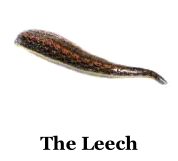 You won’t find a leech in a trout’s stomach if you spoon it - the creature is too fragile to withstand the insult of being eaten! But it’s a reasonable assumption that the omnivorous trout will eat whatever happens along. These creatures can be found world-wide and in running and still water, so they are likely to be a common feature in all trout’s diets. Leeches are segmented worms that belong to the phylum Annelida and comprise the subclass Hirudinea. Like other oligochaetes such as earthworms, leeches share a clitellum - that’s the saddle you see towards the front of an earthworm - and are hermaphrodites. Nevertheless, they differ from other oligochaetes in significant ways. For example, leeches do not have bristles and the external segmentation of their bodies does not correspond with the internal segmentation of their organs. Their bodies are much more solid as the spaces in their coelom (the body cavity) are dense with connective tissues. They also have two suckers, one at each end, as is evident from this video.
You won’t find a leech in a trout’s stomach if you spoon it - the creature is too fragile to withstand the insult of being eaten! But it’s a reasonable assumption that the omnivorous trout will eat whatever happens along. These creatures can be found world-wide and in running and still water, so they are likely to be a common feature in all trout’s diets. Leeches are segmented worms that belong to the phylum Annelida and comprise the subclass Hirudinea. Like other oligochaetes such as earthworms, leeches share a clitellum - that’s the saddle you see towards the front of an earthworm - and are hermaphrodites. Nevertheless, they differ from other oligochaetes in significant ways. For example, leeches do not have bristles and the external segmentation of their bodies does not correspond with the internal segmentation of their organs. Their bodies are much more solid as the spaces in their coelom (the body cavity) are dense with connective tissues. They also have two suckers, one at each end, as is evident from this video.
The following video shows the attractive way in which they swim and there can be no doubt that this waving motion creates pressure waves that the trout can detect through its sensitive lateral line. This motion is copied very closely by the use of a material such as marabou, although I have also had good success with arctic fox fur - the under body fur should be used and not the coarser guard hairs or tail. It makes sense to ensure that your retrieve mimics this motion and the best way to achieve this is with a figure of eight retrieve.
A LITTLE FISH IN A BIG POND
Trout are basically lazy. They will always seek the maximum of reward for the effort they expend in looking for food. This is never truer than in the autumn when they turn to hunting for fry. Every trout water will accommodate other fish species and you can be sure that the trout will seek to take maximum advantage of this fact.
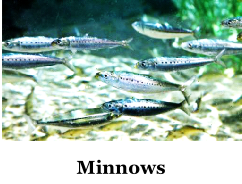 Most fish spawn in spring and the eggs hatch in early summer. This means that the water will be full of developing fry by the autumn and they will congregate in large shoals in the shallows and where they can seek shelter. Often you only have to look around the boats at the jetty or under an overhanging tree to see these shoals of small fry. And the trout know they are there too! It can be an exhilarating moment to watch the V wake as a trout tears into a shoal of fry and the small fish scatter, often coming out of the water to escape. I have sometimes thought I was caught in a sudden rainstorm when the pin fry came splashing out of the water in all directions!
Most fish spawn in spring and the eggs hatch in early summer. This means that the water will be full of developing fry by the autumn and they will congregate in large shoals in the shallows and where they can seek shelter. Often you only have to look around the boats at the jetty or under an overhanging tree to see these shoals of small fry. And the trout know they are there too! It can be an exhilarating moment to watch the V wake as a trout tears into a shoal of fry and the small fish scatter, often coming out of the water to escape. I have sometimes thought I was caught in a sudden rainstorm when the pin fry came splashing out of the water in all directions!
You should get to know where these fry shoals congregate and be prepared to use this knowledge when the first cool touches of autumn arrive. That is usually the signal for the trout to start packing on weight in preparation for their winter period of inactivity. While trout do not hibernate in the sense that many animals do, nevertheless they do enter a state of torpidity which is close to hibernation. Their opportunistic nature will encourage them to gorge on fry fish while they can, in preparation for this approaching time of hardship.
There are many fry imitation flies, such as the baby doll, woolly bugger, zonker or the muddler - who thinks these names up? I simply tie up my leech pattern in white, making sure that I have made it pretty full, which is to say put plenty of marabou into the tying. Use a forged hook a size or two larger than you would normally employ. When fry feeding the trout are ferocious - I'd like a dollar for every straightened hook I've seen at this time of year!
I believe the trout tear into the shoal of fry and use its head or its tail to smash the shoal, returning to mop up the stunned casualties. The reason I hold this notion is the number of times I seem to hook the trout in its tail or in the side of the head. It happens too often to be more than a mere accident. It is also the probable reason why so many hooks get straightened - the forces involved are too much for the average hook to hold on to. And it would explain those tremendous thumps you get when fishing this technique, which then come to nothing; the trout thumped your fly and swam on. A ploy I have used to effect is to substitute the normal hook for a double pronged hook, commonly known as a wee double. They are infinitely stronger and give you twice the chance of gaining a hold should that thump come along. Just tie the leech pattern onto this type of hook - which is available from most reputable hook suppliers and Internet fishing stores.
IT'S A BUG'S LIFE
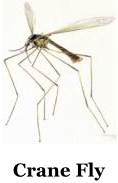 Trout will take advantage of any opportunity that comes along. Often they will take a terrestrial insect that is unfortunate enough to be blown onto the water. This will include such insects as beetles, grasshoppers, ants and crane flies (daddy longlegs) . You should always take a look at the upwind area of your water for these insects. At certain times they can be blown onto the water in large numbers, for example when an ant colony emerges from its nest in its winged form to search for places to start a new colony. You just know that the trout will be there to take advantage of this offering.
Trout will take advantage of any opportunity that comes along. Often they will take a terrestrial insect that is unfortunate enough to be blown onto the water. This will include such insects as beetles, grasshoppers, ants and crane flies (daddy longlegs) . You should always take a look at the upwind area of your water for these insects. At certain times they can be blown onto the water in large numbers, for example when an ant colony emerges from its nest in its winged form to search for places to start a new colony. You just know that the trout will be there to take advantage of this offering.
There are many imitator patterns for these insects, such as the drowned daddy and the black ant. This is also another opportunity to experiment with the closed cell foam that is used in the construction of our favourite, the booby. But now we are using it with a floating line and pulling it gently along the top of the water. Even a very rudimentary imitation is likely to bring aggressive responses from the trout. It is worth experimenting with a variety of colours and shapes - remember that the trout will be looking from underneath, so it is more important to get the shape in silhouette correct rather than the fine detail.
Make sure you associate the right insect with the right time of year. Trout are naturally wary of everything until they become used to it. They do not expect to see a daddy longlegs in spring - this is an insect of autumn. They need to see several before they become confident enough to put them on their menu. Equally, a hawthorn fly is an insect of late spring, as are the caterpillars that will fall off overhanging bushes and trees. High summer is the time of the flying ants and beetles. A little advance thought will ensure you have the right fly in your box at the right time of year.
A FLEA AND A FLY
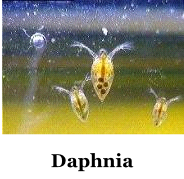 Without doubt, one of the most underrated trout food sources is the daphnia or water flea. These are tiny crustaceans that are grouped in the zooplankton category of drifting animal life. They are found in every body of water and, despite their diminutive size, make a substantial contribution to the trout's diet. I have read very little in other trout fishing literature about the daphnia. But I am convinced that they are a very significant food source. Over the years I have spooned literally hundreds of trout and almost without exception they contained some daphnia. Daphnia are very small, about the size of a pinhead - as can be seen from this video - which is why they tend to get ignored when discussing trout diets.
Without doubt, one of the most underrated trout food sources is the daphnia or water flea. These are tiny crustaceans that are grouped in the zooplankton category of drifting animal life. They are found in every body of water and, despite their diminutive size, make a substantial contribution to the trout's diet. I have read very little in other trout fishing literature about the daphnia. But I am convinced that they are a very significant food source. Over the years I have spooned literally hundreds of trout and almost without exception they contained some daphnia. Daphnia are very small, about the size of a pinhead - as can be seen from this video - which is why they tend to get ignored when discussing trout diets.
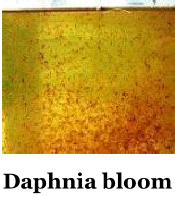 While we may not be able to imitate the water flea itself, nevertheless we can still take advantage of the trout's predisposition for this food item. We just need to work out how to fool the trout into thinking that our offering has something to do with the daphnia - and that deception is achieved with colour. Each tiny water flea has a small sac that carries some of its vital organs and has a quite distinct orange colour. It is this coloration that we take advantage of.
While we may not be able to imitate the water flea itself, nevertheless we can still take advantage of the trout's predisposition for this food item. We just need to work out how to fool the trout into thinking that our offering has something to do with the daphnia - and that deception is achieved with colour. Each tiny water flea has a small sac that carries some of its vital organs and has a quite distinct orange colour. It is this coloration that we take advantage of.
Daphnia are light sensitive and will move up and down in the water column to find the most comfortable environment. On some very overcast days I have seen huge clouds of daphnia at the water's surface. I have a theory that the trout sometimes act like a basking shark and swim through these clouds of daphnia with their mouths open sucking them in. This is borne out by observation of my fish finder, when I would watch a constant line of fish sitting at a specific depth. Some people declare that this has to do with the thermocline and that the trout sit at this depth because of the change in water temperature. That may be so. But I do know that if I put the right fly at that depth I will catch fish, but only if it is coloured pink or orange - the same colour as the blood sac of a water flea. Draw your own conclusions. The strange thing is that, although the blood sac in the daphnia is quite distinctly orange, my experiments have shown that coral pink is a more successful colour. Perhaps it has something to do with the light receptors in the trout's eye, or the way the colour coral changes at depth - who knows?
This is where I tend to depart from conventional wisdom. I believe that trout will take daphnia at any time of the year - after all, they are always there in relative abundance, apart from the deepest depths of winter. I have spooned fish at all times of the year and invariably find the odd daphnia in there somewhere. Is that an accident? I don't think so. I think the trout use the daphnia like a popcorn snack in between serious hunting expeditions. They know the daphnia sit at their most light acceptable level, so they cruise at that level just like that basking shark, vacuuming them up.
Rather than worry about matching the exact fly to the prevailing hatch and worrying even more if there is no hatch to match, I simply put out a coral pink fly and see what transpires. That makes it sound too easy. But you would be amazed at how many more times this theory works than fails. I have coral pink boobies, coral pink leeches, even coral pink coloured buzzers and they all work! The most successful is the leech - simple to tie and easy to use.
I’ll take this one step further - from my own personal experience. One gloomy summer day - the sort of day you would associate with late autumn rather than summer - I fished the whole day with just a few pulls and one fish on and lost. Finally arriving back at the jetty I noticed large plumes of daphnia between the boats and fry darting around grabbing these water fleas. A quick conversation with a friend confirmed my suspicions - the only fly fisherman, out of a whole gaggle, that had caught his bag had used an orange fritz blob fished slowly near the top of the water and an orange fritz blob is designed to emulate a clump of daphnia. I had seen fish moving in the surface - they obviously were not attacking a rise - it was too cold and windy for that to happen. But I hadn’t put two and two together. They had been sipping daphnia from the top few feet of the water where the fleas had migrated to because of the overcast conditions. Sometimes it not what you see - but understanding what you see!
Unlike tying the leech in white to imitate a fry fish or chocolate to imitate a leech, here it is tied sparingly in coral to imitate a small clump of daphnia. Then just pull or figure of eight it through the ten foot mark for best results. Even better, put a chocolate or black leech on the point and a coral on the dropper. The trout seem to perceive that the chocolate leech is chasing a clump of daphnia and - if it's good enough for the leech to eat then it's good enough for the trout! Often their competitive urge gets the better of them and they end up taking both flies! When the going gets really tough try this system with the countdown method on a medium sink line. You may find your quarry down at fifteen feet or more in really sunny weather - because that's the depth the daphnia have retired to. I have even seen monster double figure fish taken back-drifting a small coral booby through the depths on blazing summer afternoons.
LIFE CAN BE SO LOUSY
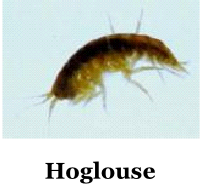 Every water will have its resident population of crustacea. This includes such creatures as the freshwater shrimp, the crawfish or crayfish and the hoglouse, known as Asellus and the genus aquaticus. On some still waters the hoglouse may be the major inhabitant of the lake bed and will constitute a major part of the trout's diet during the lean winter months.
Every water will have its resident population of crustacea. This includes such creatures as the freshwater shrimp, the crawfish or crayfish and the hoglouse, known as Asellus and the genus aquaticus. On some still waters the hoglouse may be the major inhabitant of the lake bed and will constitute a major part of the trout's diet during the lean winter months.
If you want to know what your particular fishing venue is home to, then just drag your boat anchor through a weed patch and bring it on board. You will be amazed at just how many bugs are living in that green mass. The trout know they are there too. That is why the trout patrol the outer edge of the weed beds looking to vacuum up these animals as they go. I know of one fly fisherman who would quite deliberately drag the boat anchor around before settling down to fish. The theory was that this would stir up the resident fauna and the fish would move in to feed on it. Ethical? Probably not. Practical? Well, he caught a lot of fish – until he was asked not to come back! This video shows the hoglouse and its family connection to the woodlouse is clearly evident.
The exact colour and size of all these different crustacea will vary from location to location, ranging from pale green to dark brown and from ¼ inch (6 mm) to inch ¾ (18 mm). You don't need to be too specific, as long as you get your offering near the edge of that weed bed. Don't forget that other little trick of looking for the diving ducks. They are feeding on the tender roots of those weeds and pulling them up to get at the juiciest parts. The trout cruise in behind the ducks to take any little creatures that have just been made homeless - just when they thought their day couldn't get any worse!
SNAILS AND BOATS
A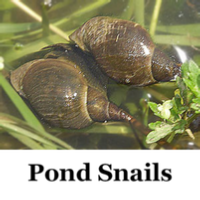 nother creature living among the submerged vegetation is the water snail. Trout will forage for these, picking them off the stalks of the water plants. Some trout become obsessed with these easy pickings and can become difficult to tempt with any other offering. At certain times of the year the water snail will float to the surface and use the currents to migrate to different parts of the lake or reservoir. Keep your eyes open for this event and then put a floating snail pattern out to ambush any trout taking advantage of it. Yet another opportunity to use the closed cell foam to make a floating fly creation. If you're feeling really lazy you can always put one on a hi-d line with a short leader and chuck it out next to a weed bed and have a snooze. Just make sure the rod is secured or else it could end up in the weed bed too! The video shows how busy water snails can be in a fish tank when they find some cucumber!
nother creature living among the submerged vegetation is the water snail. Trout will forage for these, picking them off the stalks of the water plants. Some trout become obsessed with these easy pickings and can become difficult to tempt with any other offering. At certain times of the year the water snail will float to the surface and use the currents to migrate to different parts of the lake or reservoir. Keep your eyes open for this event and then put a floating snail pattern out to ambush any trout taking advantage of it. Yet another opportunity to use the closed cell foam to make a floating fly creation. If you're feeling really lazy you can always put one on a hi-d line with a short leader and chuck it out next to a weed bed and have a snooze. Just make sure the rod is secured or else it could end up in the weed bed too! The video shows how busy water snails can be in a fish tank when they find some cucumber!
F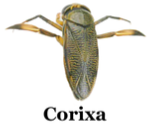 inally, the water boatman is yet another addition to the trout's diet. We have all seen these little guys skittering around the water's edge. They really do look like they are using a pair of oars as they skim across the top of the water. Their proper name is Corixa and they will make frequent trips to the surface to replenish the air bubble that they have to depend upon. They, too, have an airborne mating period and often feature prominently on the trout's menu in late summer and early autumn.
inally, the water boatman is yet another addition to the trout's diet. We have all seen these little guys skittering around the water's edge. They really do look like they are using a pair of oars as they skim across the top of the water. Their proper name is Corixa and they will make frequent trips to the surface to replenish the air bubble that they have to depend upon. They, too, have an airborne mating period and often feature prominently on the trout's menu in late summer and early autumn.
The following video demonstrates the rapid and jerky nature of the swimming abilities of Corixa and this should be imitated when using a fly to copy it. Corixae live in the shallow margins, normally near a weed bed. They will come to the surface to replenish their air and then dive back to the bottom where they hunt. The best way to emulate this is to use a floating line with a ten foot leader. Cast your weighted Corixa imitation parallel to the weed bed and allow it to sink to the bottom. Retrieve with a jerky figure of eight, allowing the fly to come to the surface and then stop to let it to fall to the bottom again. When you have about a rod length of line left slowly lift your rod and bring the fly to the surface and allow it to hang for a moment. If no takes occurs then re-cast, using a fan system to cover the water in front of you before moving a few paces along the bank.
All in all, it takes a little observation to work out what the trout are likely to be feeding on and where they are doing it. I am always amazed at the number of anglers who put their gear together in the car park before they have even taken one look at the water. How do they know they will need a floating line with just that particular fly? Or a hi-d line with exactly that length of leader? I find I have to go and take a look and work it all out before I put a rod together or open my reel case. Perhaps that's why I always seem to end up with a full bag of fish and they end up with complaints about how the fishing is no good anymore and it's the fishery's fault for not stocking enough fish!
Use your eyes. Use your common sense. Catch more fish!
BACK TO TOP
TABLE OF CONTENTS
